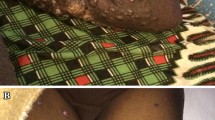Abstract
Emtricitabine (FTC) has been reported to cause skin pigmentation (SP), and the incidence of SP associated with FTC varied with ethnicity, with a higher rate in African-American patients (8%). We assessed the incidence of SP in Japanese HIV-1-infected patients receiving combination antiretroviral therapy (cART) with FTC for a period of 48 weeks and confirmed new findings of FTC-associated SP, including pathological characteristics. This was a multicenter, prospective, longitudinal non-randomized study. We evaluated the appearance of SP at 48 weeks as the primary endpoint in 155 Japanese patients, and secondary endpoints included the characteristics of the SP (location, color tone, size, and progression). Six cases (3.9%) of SP occurred at a median of 124 days (range: 7–259 days) within 48 weeks. The SP looked like an isolated dark spot, 1–2 mm in diameter, mainly on the hands and/or feet. The severity of all the SPs was mild. Each SP had disappeared or faded at a median of 112 days (range: 28–315 days) with continued FTC. FTC-associated SP was considered to be lentigo simplex by dermatoscopy and pathological appearance. In summary, the incidence of FTC-associated SP in Japanese patients was 3.9%, and was comparable to the previously reported incidence in Asian patients (4%). FTC-associated SP was not associated with any clinically significant symptoms and has little clinical significance.


Similar content being viewed by others
References
DHHS Panel on Antiretroviral Guidelines for Adults and Adolescents. Guidelines for the use of antiretroviral agents in HIV-1-infected adults and adolescents. Available from: http://aidsinfo.nih.gov/contentfiles/AdultandAdolescentsGL.pdf. Accessed September 13th, 2010.
European AIDS Clinical Society (EACS). Guidelines for the clinical management and treatment of HIV infected adults in Europe. Available from: http://www.europeanaidsclinicalsociety.org/guidelinespdf/1_Treatment_of_HIV_Infected_Adults.pdf. Accessed September 13th, 2010.
Mondou E, Hinkle J, Shaw A, Quinn J, Adda N, Rousseau F. Incidence of skin discoloration across phase 3 clinical trials of emtricitabine (FTC) in adults. Poster no. 5916. 15th International AIDS Conference July 11–16, 2004, Bangkok, Thailand.
Furth PA, Kazakis AM. Nail pigmentation changes associated with azidothymidine (Zidovudine). Ann Intern Med. 1987;107:350.
Panwalker AP. Nail pigmentation in the acquired immunodeficiency syndrome (AIDS). Ann Intern Med. 1987;107:944–5.
Greenberg RG, Berger TG. Nail and mucocutaneous hyperpigmentation with azidothymidine therapy. J Am Acad Dermatol. 1990;22:327–30.
Rawlings MK, Calderon R, Albert A, Lewis R, Wallace R. The evaluation of palmar freckling in HIV positive patients of African descent at a single center. Poster no. PE9.1/6. 10th European AIDS Conference (EACS) November 17–20, 2005, Dublin, Ireland.
Kiser JJ, Carten ML, Aquilante CL, Anderson PL, Wolfe P, King TM, et al. The effect of lopinavir/ritonavir on the renal clearance of tenofovir in HIV-infected patients. Clin Pharmacol Ther. 2008;83(2):265–72.
Gallant JE, Moore RD. Renal function with use of a tenofovir-containing initial antiretroviral regimen. AIDS. 2009;23(15):1971–5.
Goicoechea M, Liu S, Best B, Sun S, Jain S, Kemper C, California Collaborative Treatment Group 578 Team, et al. Greater tenofovir-associated renal function decline with protease inhibitor-based versus nonnucleoside reverse-transcriptase inhibitor-based therapy. J Infect Dis. 2008;197(1):102–8.
Pozniak AL, Gallant JE, Dejesus E, Arribas JR, Gazzard B, Campo RE, et al. Tenofovir disoproxil fumarate, emtricitabine, and efavirenz versus fixed-dose zidovudine/lamivudine and efavirenz in antiretroviral-naive patients: virologic, immunologic, and morphologic changes—a 96-week analysis. J Acquir Immune Defic Syndr. 2006;43(5):535–40.
Molina JM, Andrade-Villanueva J, Echevarria J, Chetchotisakd P, Corral J, David N, CASTLE study Team, et al. Once-daily atazanavir/ritonavir compared with twice-daily lopinavir/ritonavir, each in combination with tenofovir and emtricitabine, for management of antiretroviral-naive HIV-1-infected patients: 96-week efficacy and safety results of the CASTLE study. J Acquir Immune Defic Syndr. 2010;53(3):323–32.
Benson CA, van der Horst C, Lamarca A, Haas DW, McDonald CK, Steinhart CR, FTC-303/350 Writing Group, et al. A randomized study of emtricitabine and lamivudine in stably suppressed patients with HIV. AIDS. 2004;18(17):2269–76.
Acknowledgments
We thank Dr. Koh Yamanaka (Shinjuku Higashiguchi Clinic), Dr. Takeshi Fujii (Department of Infectious Diseases and Applied Immunology, Research Hospital, The Institute of Medical Science, The University of Tokyo), and Dr. Tsuyoshi Oishi (Department of Infectious diseases, Tokyo Medical University Ibaraki Medical Center) for providing data. Also we express gratitude to the study participants for their cooperation.
Conflict of interest
All authors: no conflicts.
Author information
Authors and Affiliations
Corresponding author
About this article
Cite this article
Shirasaka, T., Tadokoro, T., Yamamoto, Y. et al. Investigation of emtricitabine-associated skin pigmentation and safety in HIV-1-infected Japanese patients. J Infect Chemother 17, 602–608 (2011). https://doi.org/10.1007/s10156-011-0222-5
Received:
Accepted:
Published:
Issue Date:
DOI: https://doi.org/10.1007/s10156-011-0222-5




